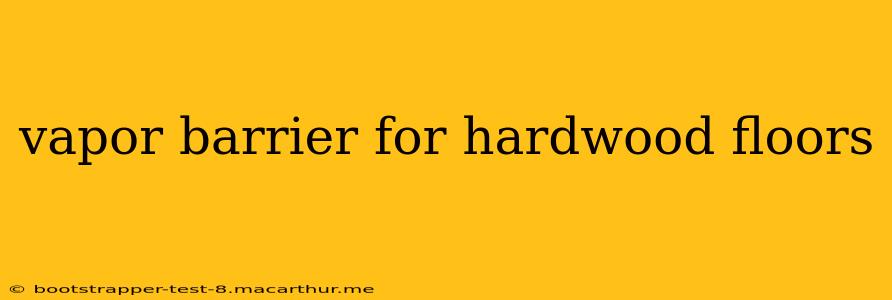Hardwood floors are a beautiful and valuable addition to any home, but their longevity depends on several factors, including proper installation and protection from moisture. One crucial aspect often overlooked is the use of a vapor barrier beneath the hardwood. This guide will explore the importance of vapor barriers for hardwood floors, addressing common questions and concerns.
What is a Vapor Barrier and Why is it Important for Hardwood Floors?
A vapor barrier is a material designed to prevent moisture vapor from passing through it. In the context of hardwood flooring, it acts as a shield against moisture rising from the subfloor, which can cause significant damage to the wood. This damage can manifest as cupping, crowning, buckling, and even rot, leading to costly repairs or replacements. The type of subfloor (concrete, plywood, etc.) greatly influences the need for a vapor barrier. Concrete slabs, especially in humid climates, are notorious for releasing moisture. A vapor barrier prevents this moisture from reaching the wood, protecting your investment.
Do I Need a Vapor Barrier Under My Hardwood Floors?
This is a critical question, and the answer depends on several factors:
- Climate: Homes in humid or damp climates are more likely to benefit from a vapor barrier. Moisture levels are consistently higher, increasing the risk of damage to hardwood floors.
- Subfloor Type: Concrete slabs often require a vapor barrier, as they tend to retain moisture. Plywood subfloors, especially if adequately sealed, may not always necessitate a vapor barrier, but it's often a good preventative measure.
- Moisture Content of Subfloor: Testing the moisture content of the subfloor is crucial. A professional moisture meter reading can help determine if a vapor barrier is necessary. High moisture content strongly suggests its use.
What are the Different Types of Vapor Barriers for Hardwood Floors?
Several materials can effectively act as vapor barriers:
- Polyethylene Sheeting: A common and cost-effective option, polyethylene sheeting is a plastic film that effectively blocks moisture. It’s available in various thicknesses, with thicker sheeting offering better protection.
- Asphalt-Impregnated Paper: This is a traditional option but may not offer the same level of protection as polyethylene sheeting.
- Vapor Barrier Paint: While less common, specialized vapor barrier paints can be applied to concrete subfloors to prevent moisture transmission.
How Do I Install a Vapor Barrier Under Hardwood Floors?
Installation is relatively straightforward:
- Prepare the Subfloor: Ensure the subfloor is clean, level, and dry. Any cracks or imperfections should be repaired before installation.
- Lay the Vapor Barrier: Overlap the sheets of vapor barrier by at least 6 inches (15 cm) and seal the seams with vapor-barrier tape to create a completely sealed surface. Ensure there are no gaps or tears.
- Install the Underlayment: This provides additional cushioning and protection for the hardwood. Choose an underlayment that is compatible with your chosen hardwood and vapor barrier.
- Install the Hardwood Flooring: Follow the manufacturer's instructions for installation.
What Happens if I Don't Use a Vapor Barrier?
Failing to use a vapor barrier in a high-moisture environment or on a concrete subfloor with high moisture content can lead to significant problems:
- Cupping: The edges of the wood planks curl upwards.
- Crowning: The center of the plank bulges upwards.
- Buckling: The planks warp and rise significantly.
- Rot: In severe cases, the wood can rot, requiring complete floor replacement.
Can I Use a Vapor Barrier Over Existing Hardwood Floors?
No, you cannot effectively install a vapor barrier over existing hardwood floors. A vapor barrier needs to be installed beneath the hardwood during the initial installation process. Attempting to add it later is ineffective and could trap moisture, leading to further problems.
What are the Best Practices for Preventing Moisture Damage in Hardwood Floors?
Beyond vapor barriers, consider these practices:
- Proper Ventilation: Ensure adequate ventilation in the home, especially in crawl spaces or basements.
- Climate Control: Maintain a consistent indoor humidity level with a dehumidifier, especially during humid months.
- Regular Inspection: Periodically check for signs of moisture damage.
By understanding the role of vapor barriers and following these best practices, you can significantly extend the life of your hardwood floors and enjoy their beauty for years to come. Remember to always consult with a flooring professional for specific guidance based on your home's conditions and your chosen hardwood type.
